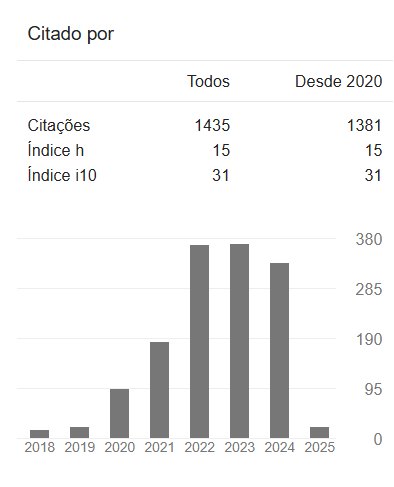TEACHER TRAINING: APPLICABILITY OF TDIC
DOI:
10.23926/RPD.2022.v7.nEspecial.e22105.id1765Keywords:
Teacher training, TDIC, ODAAbstract
The present study is part of the Academic Master's Course in Teaching of the Stricto Sensu Graduate Program - PPGEn, by the Federal Institute of Education, Science and Technology of Mato Grosso (IFMT, 2020), Campus Cuiabá, whose objective is to reflect on teacher training and the applicability of TDIC in pedagogical practice. The discussions were based on the view of some authors: Belloni, 2009; Freire, 1996; Moran, 2014; Coscarelli and Ribeiro, 2007; Dudeney, Hockly and Pegrum, 2016; Rojo, 2013; Santaella, 2007, among others, which corroborate the concepts of training, teaching knowledge and digital technologies. The qualitative approach and the case study were used as a method. In the development of the field investigation, the instruments used for data recording were a questionnaire, semi-structured interview and observation. From the results, we understand the relationship and use of TDIC in teacher training and the digital inclusion of both teachers and their students. We conclude that, with regard to teacher training, there is a need for dialogue about the technological culture and reflections on the potential that TDICs imply in teaching knowledge.
Downloads
Metrics
References
ALMEIDA, Maria Cristina. As tecnologias da informação e comunicação (TIC), os novos contextos de ensino-aprendizagem e a identidade profissional dos professores. (2002). Disponível em: http://www.inep.gov.br/pesquisa/bbe-online.asp. Acesso em: 15 out. 2019. DOI: https://doi.org/10.24109/2176-6681.rbep.89i221.723
BRASIL. Lei nº 9.394, de 20 de dezembro de 1996. Estabelece as diretrizes e bases da educação nacional. Diário Oficial da União, Brasília, 23 de dezembro de 1996. Disponível em: http://www.planalto.gov.br/ccivil_03/leis/L9394.htm. Acesso em: 15 out. 2019.
BELLONI, Maria Luiza Educação à distância. 5. ed. Campinas-SP: Autores Associados, 2009.
BRZEZINSKI, Íria GARRIDO, Elsa. Análise dos trabalhos do GT Formação de Professores: O que revelam as pesquisas do período 1992-1998, Revista Brasileira de Educação, nº18. Campinas, Autores Associados. 2001. DOI: https://doi.org/10.1590/S1413-24782001000300008
FANTINATO, Tania Mara. Formação docente para a diversidade. 1. ed. - Curitiba, PR: IESDE BRASIL S/A, 2014.
FREIRE, Paulo. Pedagogia da Autonomia: saberes necessários à prática educativa. 17. ed. São Paulo: Paz e Terra, 1999.KENSKI, Vani Moreira. Tecnologias e Ensino Presencial e à Distância. 9. ed. São Paulo: Papirus, 2012.
KLEIMAN, Angela; MATENCIO, Maria de Lourdes Meireles. Letramento e Formação do Professor: práticas discursivas, representações e construção do saber. (orgs.). Campinas, SP: Mercado de Letras, 2005 – Coleção idéias sobre Linguagem.
MORAES, Maria Candido. O paradigma educacional emergente. (1993). Disponível em: . Acesso em: Acesso em 20 jul. 2019.
MORAN, José Manuel. Como utilizar a internet na educação. Revista Ciência da Informação, v. 26, n. 2, maio-ago. (2007). Disponível em: http://doi.org/101590/S010019651997000200006. Acesso em: 15 Mai. 2019.
MORAN, José Manuel. A Educação que Desejamos: Novos desafios e como chegar lá. 5. ed. Campinas: Papirus, 2000.
NÓVOA, Antonio. Os professores e as histórias da sua vida. In: NÓVOA, A. (Org.). Vidas de professores. Trad. Maria dos Anjos Caseiro, Manuel Figueiredo Ferreira. Portugal: Porto Editora, LTDA, 2000.
TARDIF, Maurice. Saberes docentes e formação profissional. São Paulo: Editora Vozes Limitada, 2014.
VALENTE, José Armando. (1999). Criando Oportunidades de Aprendizagem continuada ao longo da vida. Pátio Revista Pedagógica, Ano IV, número 15, Porto Alegre: Artmed Editora Ltda.
VIEIRA, Rosangela Souza. O Papel das tecnologias da informação e comunicação na educação a distância: um estudo sobre a percepção do professor/tutor. Revista Brasileira de Aprendizagem Aberta e a Distância, São Paulo, v. 10, p. 65-70, 2011. DOI: https://doi.org/10.17143/rbaad.v10i0.233
WILEY, David. Connecting learning objects to instructional design theory: A definition, ametaphor, and a taxonomy. 2000. In D. A. Wiley (Ed.), The Instructional Use of Learning Objects: Online Version. Disponível em: http://reusability.org/read/chapters/wiley.doc. Acesso em: 6 jun. 2018.
Downloads
Published
How to Cite
Issue
Section
License
Copyright (c) 2023 A Revista Prática Docente tem o direito de primeira publicação

This work is licensed under a Creative Commons Attribution-NonCommercial 4.0 International License.
Authors who publish in this journal agree to the following terms:
- Authors retain the copyright and grant the journal the right of first publication, with the paper simultaneously licensed under the Licença Creative Commons Attribution allows the sharing of the work with acknowledgment of authorship and initial publication in this journal.
- Authors are authorized to take additional contracts separately, for non-exclusive distribution of the version of the work published in this journal (e.g. publish in institutional repository or as a book chapter), with acknowledgment of authorship and initial publication in this journal.











